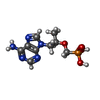+Search query
-Structure paper
| Title | Molecular basis for selective uptake and elimination of organic anions in the kidney by OAT1. |
|---|---|
| Journal, issue, pages | Nat Struct Mol Biol, Vol. 30, Issue 11, Page 1786-1793, Year 2023 |
| Publish date | Jul 23, 2023 |
 Authors Authors | Joanne L Parker / Takafumi Kato / Gabriel Kuteyi / Oleg Sitsel / Simon Newstead /   |
| PubMed Abstract | In mammals, the kidney plays an essential role in maintaining blood homeostasis through the selective uptake, retention or elimination of toxins, drugs and metabolites. Organic anion transporters ...In mammals, the kidney plays an essential role in maintaining blood homeostasis through the selective uptake, retention or elimination of toxins, drugs and metabolites. Organic anion transporters (OATs) are responsible for the recognition of metabolites and toxins in the nephron and their eventual urinary excretion. Inhibition of OATs is used therapeutically to improve drug efficacy and reduce nephrotoxicity. The founding member of the renal organic anion transporter family, OAT1 (also known as SLC22A6), uses the export of α-ketoglutarate (α-KG), a key intermediate in the Krebs cycle, to drive selective transport and is allosterically regulated by intracellular chloride. However, the mechanisms linking metabolite cycling, drug transport and intracellular chloride remain obscure. Here, we present cryogenic-electron microscopy structures of OAT1 bound to α-KG, the antiviral tenofovir and clinical inhibitor probenecid, used in the treatment of Gout. Complementary in vivo cellular assays explain the molecular basis for α-KG driven drug elimination and the allosteric regulation of organic anion transport in the kidney by chloride. |
 External links External links |  Nat Struct Mol Biol / Nat Struct Mol Biol /  PubMed:37482561 / PubMed:37482561 /  PubMed Central PubMed Central |
| Methods | EM (single particle) |
| Resolution | 3.43 - 3.94 Å |
| Structure data | EMDB-16269, PDB-8bvr: EMDB-16270, PDB-8bvs: EMDB-16271, PDB-8bvt: EMDB-16280, PDB-8bw7: EMDB-16977, PDB-8omu: |
| Chemicals |  ChemComp-PO4:  ChemComp-TFO:  ChemComp-CL:  ChemComp-RTO:  ChemComp-AKG: |
| Source |
|
 Keywords Keywords | MEMBRANE PROTEIN / transporter / METAL TRANSPORT |
 Movie
Movie Controller
Controller Structure viewers
Structure viewers About Yorodumi Papers
About Yorodumi Papers














